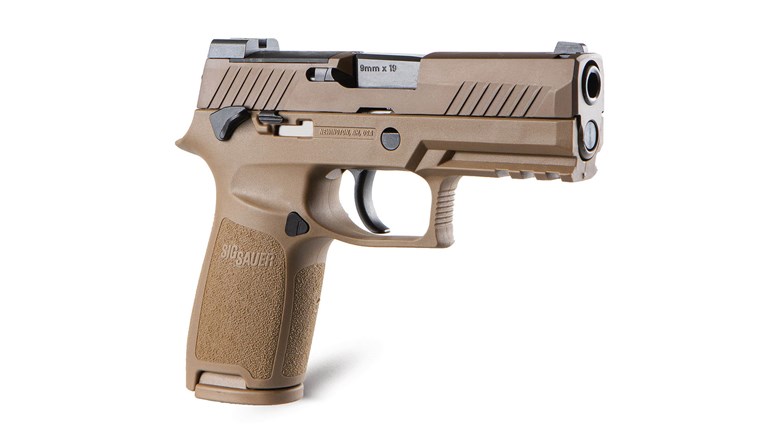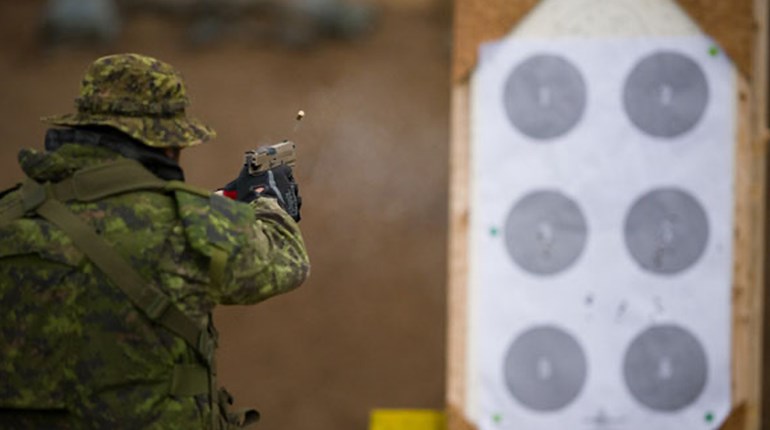Unlike many Midwest whitetail hunters, I was not surprised to see "America's" favorite deer on the cold, windy, barren plains of eastern Alberta. But I was pleasantly surprised to see the size of their antlers.
Huge. In keeping with the rest of them. The largest whitetails in the world live up there, and they grow antlers to match. The world record Hansen buck was shot just across the line in Saskatchewan. But, despite living in what traditional whitetail hunters would consider a bald tabletop, Alberta bucks are not easy to catch.
"I see two coming in from the south," Billy said. "Just above that little herd of mule deer." I tore my eyes from the 14 mule deer I'd been watching approach from the east, shuffled 'round in the frosty grass and focused my binocular to the distant rim of the grassy valley southwest of our perch.
"Got 'em. Heading into that patch of snowberries and roses, I'm guessing. Looks like a decent 4x4, eh?" When in Canada it doesn't take me long to start talking like the locals, eh?
"Yeah. Borderline, but worth a closer look. If we can get past these mule deer we'll head over there and check him out, eh?" By "these mule deer," my guide didn't mean just the 14 coming from the east or the little band below the approaching whitetails. He also meant the dozen scattered across the wide, shallow valley below us.
"And here come two coyotes," he added. "We'll have to sit tight."
Those are the kinds of problems one suffers when hunting Alberta plains whitetails: Tough as it is to get within range of them in their open habitat, it's even tougher with all the other wildlife on the watch. This melting pot of habitats supports not just whitetails and mule deer and coyotes, but pronghorns and elk and even moose. More than once while hunting Alberta we've had four species of deer in view at one time with coyotes prowling the fringes. Once another hunter and guide in camp came back with cell-phone photos of a mountain lion that walked into the draw they were watching. It laid down like a cat and groomed itself for a half hour while they watched and wished they'd bought a lion tag.
Billy and I eventually did crawl and slither within 400 yards of those two whitetails. By the time we did, they'd bedded near the top of that snowberry thicket. A good mule deer buck was hiding near its bottom. We could have shot both. I had the tags. But it was our first day and neither buck quite made our standards.
"I might regret passing up this chance," I whispered as we lay in the grass studying both bucks. "But, as they say, you don't get the big one by shooting the first enticing buck you see."
"Or bucks, in this case," Billy replied. Don't rub it in, man.
We backed out of that delightful conundrum, and I almost regretted it until the last day of our four-day hunt. By then we'd looked over dozens of mule deer and whitetails as big as the pair we passed up plus several a fair bit bigger. We passed those, too. I was being extra fussy because Alberta has a reputation for really big antlers atop both species. And we eventually found them.
■■■
After glassing the rolling hills and bluffs above the Red Deer River Valley, watching four deer species finish their morning meal and slip into various hidden bedding sites, we decided some drives would shake up the neighborhood and maybe roust up the big boys.
"Nothing to lose at this point, fellas," someone said. "Last afternoon and all, eh?"
Driving involves posting blockers at the upper ends of draw complexes while one or two drivers walk up the bottoms, shooing out any and all cloistered bucks. Some of these drainages, which draw snowmelt and rainwater off the grassy uplands, are carved into elaborate, twisting mini-canyons in which all kinds of critters can hide. On this particular hunt, my partner, Mike Slack from Leupold, was in nearly the same leaky boat as I. He still had both his tags, too, but he was more interested in a whitetail than I because he'd never shot one. Being the self-sacrificing, magnanimous, generous, charitable, benevolent soul I am, I reluctantly agreed to give him first crack at any good whitetails that popped up. I came to regret that indulgence on the very first drive.
Mike was watching a side draw about 400 yards west of me when our guides pushed out a towering whitetail that squirted—wouldn't you know it—past me. The antlers said "shoot!" My conscience said "shoot," as in, "Shucks, why did I agree to this deal?" No mule deer showed. When we coalesced at the end of the drive, I described the whitetail I'd seen, casually mentioning I didn't shoot it because I wanted Mike to have the chance. "But you said it was going the exact opposite way!" Mike noted. "How was I supposed to shoot it?" And just then, as I stared out across the landscape, trying to come up with an explanation for my inexplicable behavior, I saw—no kidding—the same whitetail running out of the foothills and across the flat prairie river bottom. But it didn't go far. Instead of continuing to the riparian trees near the water, it dived into a lonely patch of snowberry shrubs and lay prone, giving me my much-needed answer.
"Mike," I said, "you are to shoot it by marching down there, jumping him out of that thicket and shooting him. Don't miss."
Of course, Mike, Billy and everyone else saw the buck before it disappeared, so Mike was ready to make the attempt. We stayed on top to watch the show. I'm remembering that thicket to be at least a mile away, so the participants looked pretty tiny as they kicked through it. For a moment it appeared that buck had somehow sneaked off when no one was looking, but then Mike must have nearly stepped on it because up it leapt. And down it fell. And finally a muffled boom rolled up the hills. Mike had gotten not just his first Alberta whitetail, but his first whitetail. At 20 yards. And it was a beauty.
Karma worked quickly that day. At sundown, looking into our last draw of the day, we spotted a big, bouncing mule deer buck. It was so close that I managed to hit it. The antlers taped out at 185 inches, a nice counterpoint to the 150-class whitetail Mike had taken.
■■■
Since that trip I've returned to Alberta several times for whitetails of my own, most often hunting with Willow Creek Outfitters and owner and guide André van Hilten, who could just as well go by André the Giant. He's tall enough, but cowboy lanky. The "giant" part refers to his ability to get clients into deer. The first year I hunted with him he uncovered a 140-class whitetail 2 miles away, something no Midwest outfitter or hunting buddy has ever done. It's an Alberta thing. Well, it's a tactic we use all across Plains whitetail habitat, but André does it to perfection, sitting in his truck on roadsides, out of the nasty Arctic winds sweeping off the scenic, snow-topped peaks looming on the western horizon. "No need to suffer out there any longer than we have to," he wisely says, his right eye unwavering behind the 20X-60X scope mounted to his truck door. "But if you want to, we could hike over to those foothills and see about this buck." He'd found a beefy, fully mature specimen, the kind with a neck as wide as its chest, so big and bulky that its 5x5 antlers seemed too small. "Trust me, it's a 140-class buck," André insisted while I debated. I finally played it smart and dropped the animal with a single 150-grain Scirocco from my M700 .30-06. André was correct, of course. It was a fine 10-point, and, despite its age, the venison was delicious. Aging an old buck usually cures any lingering toughness issues.
That hunt worked so well that I returned two years later. Again we saw elk, moose, mule deer, coyotes and whitetails. The whitetails, however, were spread across 4 square miles of flat grassland. We glassed them from the road and tried several approaches, foiled by the wind, the open terrain and twice by coyotes that chased the bedded bucks away before we could slip within shooting range. This went on day after day. At one time I counted six hunting coyotes in one view through a 60X Swarovski spotting scope. We waited until they and all the deer bedded, then started a 3-mile, roundabout stalk, but just as we were closing the last 200 yards for the shot, one of the coyotes woke and bungled right into the bedded buck. He didn't stick around to defend his bedroom. That hunt went down to the final afternoon, too, but we finally caught a coterie of does teasing a rutting buck in a thicket of willows. "Range that little opening where that last doe ran through," I told André. We were sitting above the thicket, trying to lure the buck out with rattling and grunting. He was too busy chasing, and I anticipated he'd come through the same opening as that doe.
"It says 411 yards," André reported. "Think you can make that shot?" I was carrying a Mossberg 4x4 in 7mm Rem. Mag. that consistently dropped 150-grain Ballistic Silvertips into a pie plate at 400 yards. All I had to do was hold to show a little daylight between the horizontal reticle and a deer's back. I snuggled my back against my pack, pressed elbows into my knees and the rifle's fore-end into my portable shooting sticks. The reticle held steady on a clump of grass in the distant opening.
"I can make it if I have to." I had to. The buck would not come to our rattling and the wind would not let us risk a closer approach. So we held tight, watched as yet another doe dashed across the opening. I got ready.
"Here he comes!" André hissed. "From the left. I saw antlers. Make sure it's the right one." And then the buck was there, trotting happily in the advanced stages of rut fever, oblivious to all but the intoxicating aroma of ripe doe.
"Hey!" I shouted. The buck stopped and looked up through fevered eyes. The rack was wide enough. Five points on one side. It was him. I held over his withers. The Mossberg bucked and the buck crumpled. I stayed on the small patch of hide still visible in the grass for another minute, but it didn't twitch. Now all we had to do was walk down there, bone him out, pack him up and hike 3 miles back to the truck, dodging moose, mule deer and coyotes while the temperature dropped and ice crystals grew on leaves of grass.
I'll hunt America's deer on Canada's Alberta plains anytime.





































